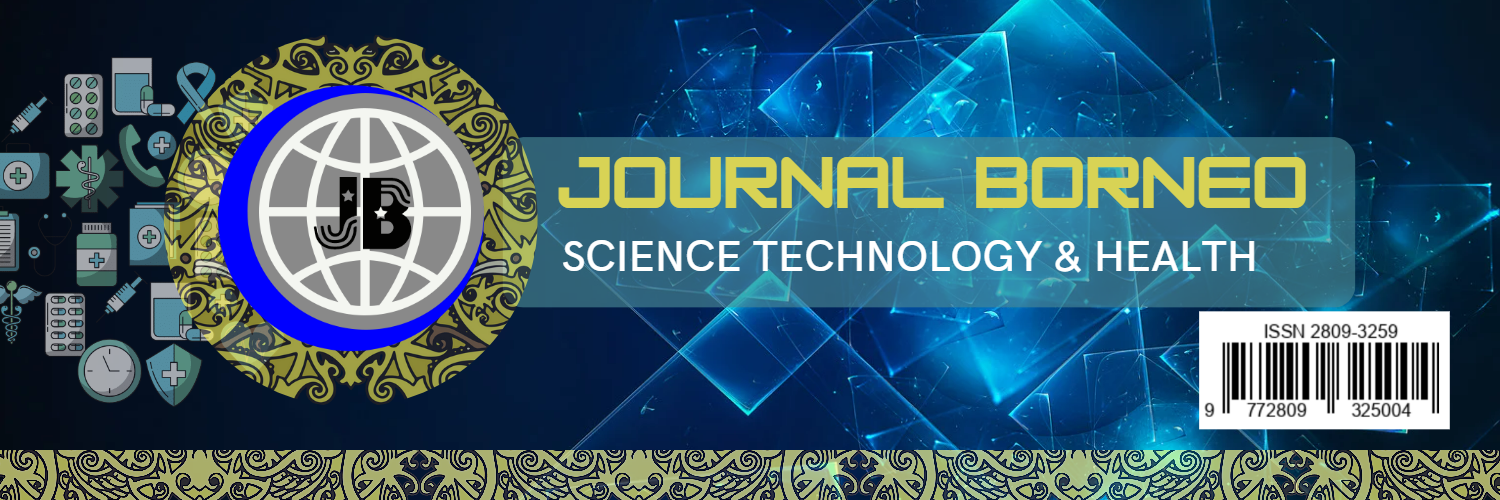Aktivitas Antimikroba Ekstrak Etanol Rimpang Kunyit, Jahe, dan Lengkuas dalam Kombinasi menggunakan Metode Checkerboard
DOI:
https://doi.org/10.57174/j.born.v3i3.108Kata Kunci:
jahe, kombinasi, kunyit, lengkuas, sinergisAbstrak
Infeksi bakteri masih menjadi masalah besar di seluruh dunia dan memburuk dengan munculnya jenis bakteri yang resisten terhadap antibiotik. Indonesia kaya akan sumber daya alam, seperti keanekaragaman flora, dengan berbagai manfaat, termasuk untuk pengobatan. Penelitian ini bertujuan untuk menentukan potensi ekstrak etanol rimpang kunyit, jahe, dan lengkuas secara tunggal dan kombinasi menggunakan metode checkerboard terhadap beberapa patogen. Aktivitas penghambatan paling ampuh dalam bentuk tunggal ditunjukkan oleh ekstrak kunyit terhadap Streptococcus mutans dan Cutibacterium acne dengan nilai konsentrasi hambat minimum (KHM) sebesar 16 µg/mL, sedangkan aktivitas bakterisida paling baik ditunjukkan oleh ekstrak kunyit terhadap Staphylococcus aureus dan Enterococcus faecalis dengan KHM dan konsentrasi bakterisida minimum (KBM) sebesar 32 µg/mL. Kombinasi sinergis ditunjukkan oleh kunyit-jahe (TGi), kunyit-lengkuas (TGa), dan jahe-lengkuas (GiGa) terhadap Staphylococcus aureus dengan FICI (fractional inhibitory concentration Index) masing-masing sebesar 0,15625, 0,1328, dan 0,15625, dan TGi terhadap Streptococcus mutans dengan indeks konsentrasi penghambatan fraksional (FICI) sebesar 0,1875. Studi pendahuluan ini menunjukkan potensi rimpang tersebut untuk diteliti lebih lanjut guna mengetahui senyawa aktif yang memiliki aktivitas sinergis yang dapat digunakan sebagai terapi alternatif di masa depan.
Unduhan
Referensi
Nelwan EJ. The threat of emerging and re-emerging infections in Indonesia. Acta Med Indones - Indones J Intern Med. 2019;51(3).
World Bank. Population total - Indonesia [Internet]. 2022 [cited 2023 Sep 2]. Available from: https://data.worldbank.org/indicator/SP.POP.TOTL?locations=ID
CDC. CDC in Indonesia [Internet]. 2021 [cited 2023 Sep 2]. Available from: www.cdc.gov/globalhealth/countries/indonesia
Tauran PM, Djaharuddin I, Bahrun U, Nurulita A, Katu S, Muchtar F, et al. Excess mortality attributable to antimicrobial-resistant bacterial bloodstream infection at a tertiary-care hospital in Indonesia. PLOS Global Public Health. 2022 Jul 20;2(7).
Coates ARM, Hu Y, Holt J, Yey P. Antibiotic combination therapy against resistant bacterial infections: synergy, rejuvenation and resistance reduction. Expert Rev Anti Infect Ther. 2020 Jan 2;18(1):5–15.
Ayukekbong JA, Ntemgwa M, Atabe AN. The threat of antimicrobial resistance in developing countries: Causes and control strategies. Antimicrob Resist Infect Control. 2017 May 15;6.
Balouiri M, Sadiki M, Ibnsouda SK. Methods for in vitro evaluating antimicrobial activity: A review. J Pharm Anal. 2016 Apr 1;6:71–9.
Hawas S, Verderosa AD, Totsika M. Combination therapies for biofilm inhibition and eradication: A comparative review of laboratory and preclinical studies. Front Cell Infect Microbiol. 2022 Feb 25;12.
Elfahmi, Woerdenbag HJ, Kayser O. Jamu: Indonesian traditional herbal medicine towards rational phytopharmacological use. J Herb Med. 2014;4(2):51–73.
Jamaluddin AW, Mursalim MF, Apada AMS. Combination of propolis extract (Trigona Sp) and ginger rhizome (Zingiber Officinale Roscoe) as alternative antibiotics against Escherichia coli in vitro. Indonesian Journal of Pharmaceutical Science and Technology. 2019;6(3):112–7.
Pangemanan A, Fatimawali, Budiarso F. Uji daya hambat ekstrak rimpang kunyit (Curcuma longa) terhadap pertumbuhan bakteri Staphylococcus aureus dan Pseudomonas sp. Jurnal e-Biomedik. 2016;4(1):81–5.
Kumowal S, Fatimawali, Jayanto I. Uji aktivitas antibakteri nanopartikel ekstrak lengkuas putih (Alpinia galanga (L.) Willd) terhadap bakteri Klebsiella pneumoniae. Pharmacon. 2019;8(4).
Kusriani RH, Az Zahra S. Skrining fitokimia dan penetapan kadar senyawa fenolik total ekstrak rimpang lengkuas merah dan rimpang lengkuas putih (Alpinia galanga L.). Prosiding Seminar Nasional Penelitian dan PKM Kesehatan. 2015;1(1).
Subash KR, Bhaarathi MG, N JR, Cheriyan BV. Phytochemical screening and acute toxicity study of ethanolic extract of Alpinia galanga in rodents. International Journal of Medical Research & Health Sciences. 2013;2(1):93–100.
Indrawati I, Miranti M, Mayfi IR. Antibacterial activity of ethanolic extracts of rhizome from three ginger varieties against acne-isolated bacteria. Nusantara Bioscience. 2017 Feb 20;9(1):92–6.
Tyagi P, Singh M, Kumari H, Kumari A, Mukhopadhyay K. Bactericidal activity of Curcumin I Is associated with damaging of bacterial membrane. PLoS One. 2015 Mar 26;10(3).
Teow SY, Ali SA. Synergistic antibacterial activity of Curcumin with antibiotics against Staphylococcus aureus. Pak J Pharm Sci. 2015;28(6):2109–14.
Mun SH, Joung DK, Kim YS, Kang OH, Kim SB, Seo YS, et al. Synergistic antibacterial effect of curcumin against methicillin-resistant Staphylococcus aureus. Phytomedicine. 2013 Jun 15;20:714–8.
Farnsworth N. Biologycal and phytochemical screening of plants. Journal of Pharmaceutical Science. 1966;60(3).
Bellio P, Fagnani L, Nazzicone L, Celenza G. New and simplified method for drug combination studies by checkerboard assay. MethodsX. 2021;8.
Deb PK, Ghosh R, Das S, Bhakta T. Comparative anthelmintic activity of Clerodendrum indicum & Alpinia galanga leaves. Int J Pharm Pharm Sci. 2013;5(3).
Pandey J, Mishra S, Jaiswal K. In vitro evaluation of the anthelmintic activity of rhizome extracts of Curcuma longa (Linn.). Asian Journal of Pharmaceutical and Clinical Research. 2018 Dec 1;11(12):425–8.
Aziz DM, Wsoo MA, Ibrahim BM. Antimicrobial and antioxidant activities of extracts from medicinal plant ginger (Zingiber officinale) and identification of components by gas chromatography. African Journal of Plant Science. 2015 Oct 31;9(10):412–20.
Holetz FB, Pessini GL, Sanches NR, Cortez DAG, Nakamura CV, Filho BPD. Screening of Some Plants Used in the Brazilian Folk Medicine for the Treatment of Infectious Diseases. Mem Inst Oswaldo Cruz. 2002;97(7):1027–31.
Praditya D, Kirchhoff L, Brüning J, Rachmawati H, Steinmann J, Steinmann E. Anti-infective properties of the golden spice curcumin. Front Microbiol. 2019;10.
Breijyeh Z, Jubeh B, Karaman R. Resistance of gram-negative bacteria to current antibacterial agents and approaches to resolve it. Vol. 25, Molecules. MDPI AG; 2020.
Phitaktim S, Chomnawang M, Sirichaiwetchakoon K, Dunkhunthod B, Hobbs G, Eumkeb G. Synergism and the mechanism of action of the combination of α-mangostin isolated from Garcinia mangostana L. and oxacillin against an oxacillin-resistant Staphylococcus saprophyticus. BMC Microbiol. 2016 Aug 26;16(1).
Haroun MF, Al-Kayali RS. Synergistic effect of Thymbra spicata L. extracts with antibiotics against multidrug-resistant Staphylococcus aureus and Klebsiella pneumoniae strains. Iran J Basic Med Sci. 2016;19(11):1193–200.
Ilić BS, Kocić BD, Ćirić VM, Cvetković OG, Miladinović DL. An in vitro synergistic interaction of combinations of Thymus glabrescens essential oil and its main constituents with chloramphenicol. The Scientific World Journal. 2014;2014.
Betts JW, Sharili AS, La Ragione RM, Wareham DW. In vitro antibacterial activity of curcumin-polymyxin B combinations against multidrug-resistant bacteria associated with traumatic wound infections. J Nat Prod. 2016 Jun 24;79(6):1702–6.

Unduhan
Diterbitkan
Terbitan
Bagian
##category.category##
Lisensi
Hak Cipta (c) 2023 Muhammad Azhari, Riki Febriansyah Sengaji

Artikel ini berlisensiCreative Commons Attribution-NonCommercial-ShareAlike 4.0 International License.
Semua artikel yang dimuat di Jurnal Borneo memiliki hak cipta yang dipegang oleh penulis. Artikel dilisensikan berdasarkan ketentuan CC Attribution-NonCommercial-ShareAlike 4.0





















